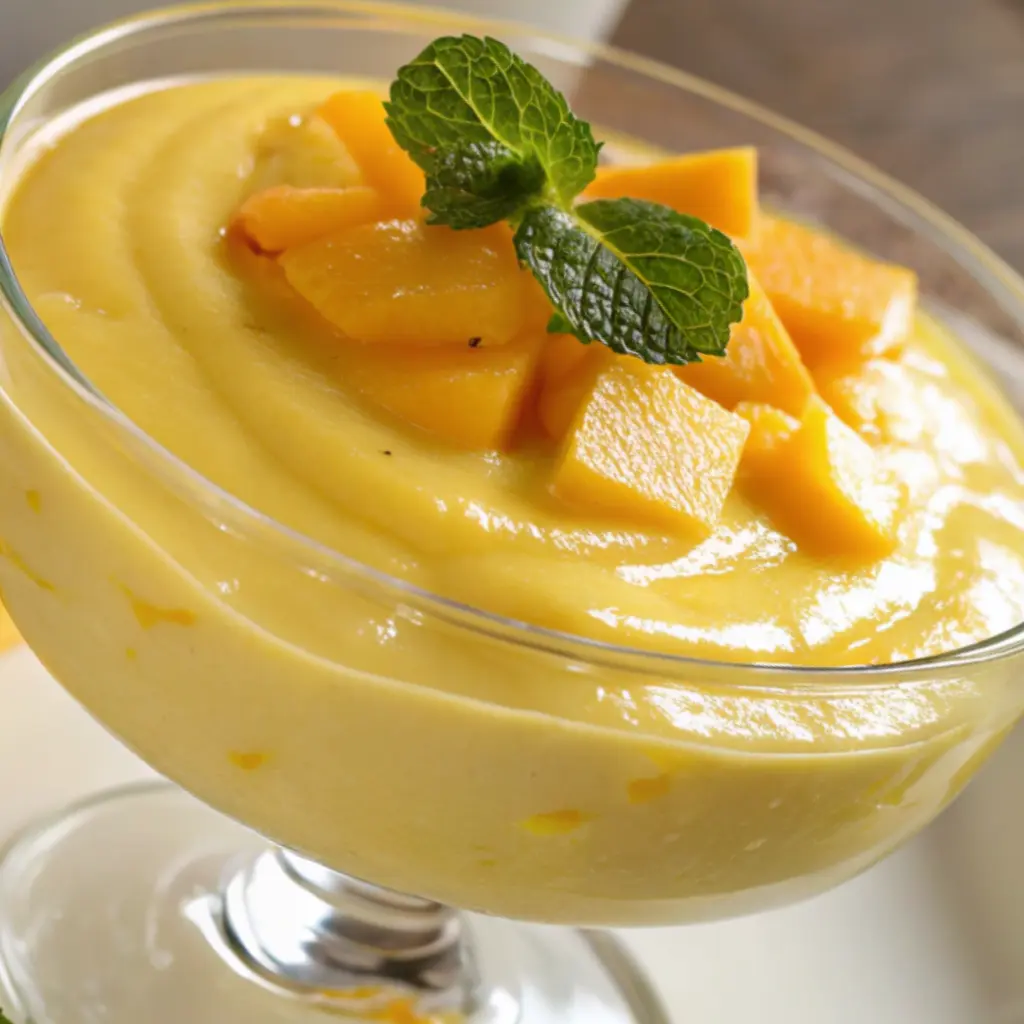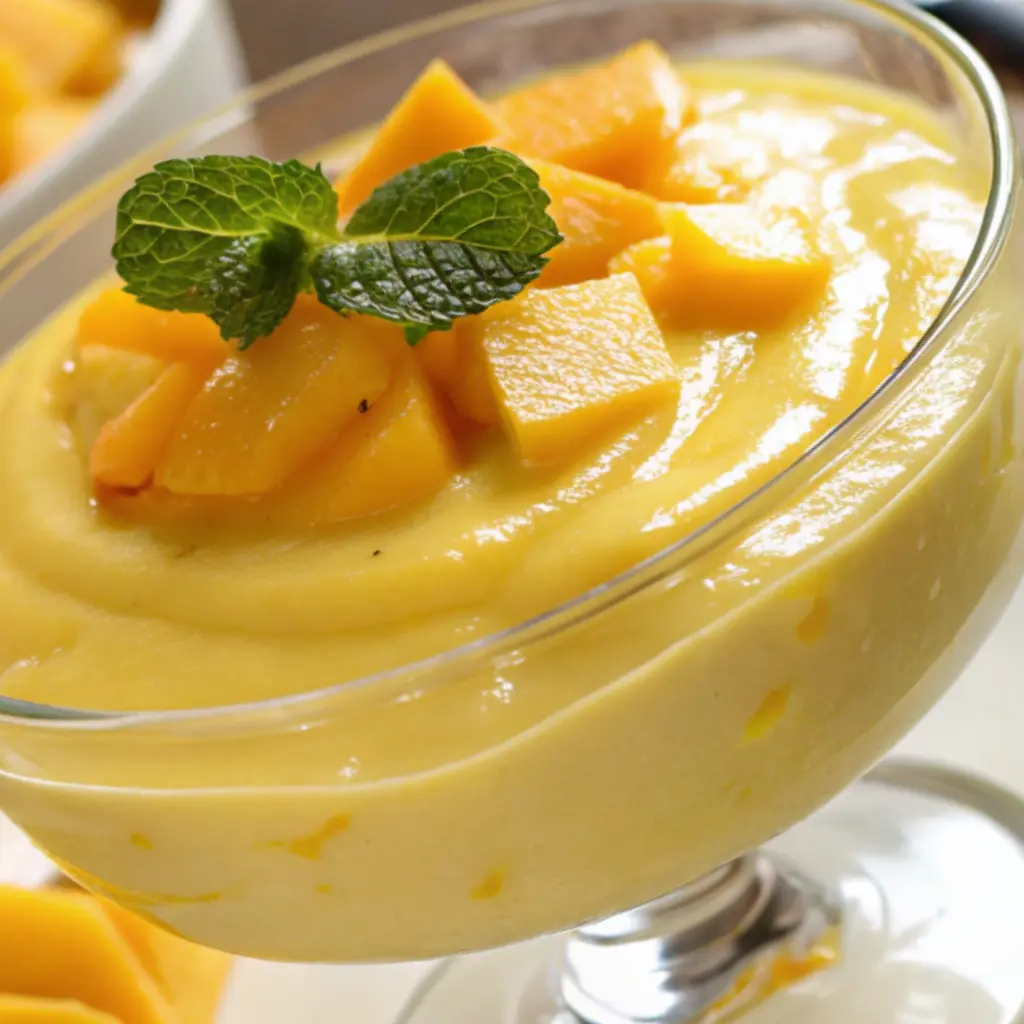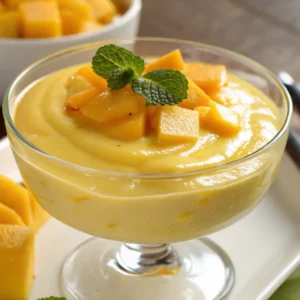There’s something about mangoes that takes me right back to my grandmother’s garden in late June. The mango tree behind her house was impossibly tall, and its branches would dip low with fruit so ripe, they practically begged to be eaten straight from the stem. My cousins and I would sit barefoot on the cracked stone path, mango juice running down our wrists, swatting away bees as we sucked every bit of golden flesh from the seed. That’s where my love for mango mousse began—not with a fancy recipe or a culinary class, but with the wild, sun-warmed sweetness of those mangoes and the way my grandmother turned them into the most impossibly silky dessert with nothing more than a bowl, a spoon, and her quiet magic.
The first time I tried to recreate her mango mousse, I was too confident for my own good. I used unripe fruit, rushed the chilling, and folded in whipped cream like I was stirring cement. The result was clumpy, watery, and not even close to the cloud-like treat I remembered. But that’s the thing about recipes that matter—they come with lessons. Over time, I learned to listen to the mangoes, to let the mousse set without peeking, and to trust in the process. Now, every time I make it, I feel a little closer to her kitchen, to those summer afternoons, and to that quiet magic I’m still trying to bottle.

Why You’ll Love This Recipe:
- Light, creamy texture that melts on the tongue
- Only a few simple ingredients
- Naturally sweet—no need for much added sugar
- Perfect make-ahead dessert for summer gatherings
- Easily adaptable for dairy-free or egg-free versions
Ingredients You’ll Need:
Ripe mangoes (3 large or about 2 ½ cups of pulp)
Fresh mango is the heart of this dish, and honestly, it makes or breaks the mousse. Ataulfo or Alphonso mangoes are my favorites—rich, floral, and naturally creamy. If you’re using frozen mango, thaw it completely and blend until smooth. Avoid fibrous varieties unless you strain them.
Heavy whipping cream (1 cup)
This gives the mousse its luscious body. Chill it well before whipping—cold cream holds air better. I’ve used coconut cream in a pinch for a dairy-free version and was pleasantly surprised by how nicely it held up.
Sweetened condensed milk (¼ cup to ⅓ cup, to taste)
This adds sweetness and richness. You can substitute it with maple syrup or honey for a more natural sweetness, though the consistency will be a bit lighter.
Unflavored gelatin (2 teaspoons or 1 packet)
It helps the mousse set into that perfect spoonable texture. If you’re vegetarian, use agar-agar (about 1 teaspoon), but bloom and dissolve it properly first—it needs a slightly different process.
Water (3 tablespoons, for blooming the gelatin)
Always bloom gelatin first to avoid any clumps later. Let it sit and swell up before warming it gently.
Lime juice (optional, about 1 tablespoon)
Just a touch brings brightness and balances the mango’s sweetness. I add it when the mangoes are extra ripe or leaning syrupy.
How to Make It (Step-by-Step Instructions):
Start by preparing the mangoes. Peel and chop them, then blend until completely smooth. You want a thick, velvety puree with no lumps—don’t rush this. If your mangoes are very fibrous, strain the puree through a fine mesh sieve. You should end up with about 2½ cups of silky gold.
In a small bowl, sprinkle the gelatin over the water and let it bloom for 5–10 minutes. This step is small but crucial—if you skip it or heat it too quickly, your mousse won’t set right. Once bloomed, warm it gently (I use 10-second bursts in the microwave or a quick simmer in a saucepan) until fully dissolved. Let it cool slightly, but not so much that it starts to firm up again.
Now, whisk the gelatin into the mango puree. I like to fold it in gradually, making sure it’s evenly mixed. This is the moment when everything starts to come together. Taste the puree now—if your mangoes weren’t sweet enough, you can stir in a little more condensed milk.
In a separate bowl, whip the cold heavy cream to soft peaks. Not stiff, not runny—just enough so it holds shape when you lift the beaters. If you go too far, the mousse can turn dense.
Gently fold the mango mixture into the whipped cream. Use a spatula, not a whisk, and go slowly, in three additions. This keeps the air in and gives the mousse its featherlight texture. It should look pale orange and billowy when it’s done.
Spoon the mousse into serving glasses or ramekins. I’ve also poured it into a single glass dish and scooped it like pudding later—do what works for you. Cover tightly with plastic wrap and chill for at least 4 hours, preferably overnight. That resting time deepens the flavor and sets the mousse into a soft, custard-like cloud.

Expert Tips for the Best Results:
Over the years, I’ve learned that the two things that truly matter in mango mousse are the ripeness of the mangoes and the gentleness of your folding. Let your fruit ripen fully—it should smell like summer and feel slightly soft to the touch. Never skip the bloom-and-dissolve step with gelatin; it seems small but changes everything. And when folding, treat the whipped cream like a shy friend—don’t overwhelm it. Keep your bowls cold, take your time, and let the mousse chill undisturbed. Rushing never does this recipe any favors.
Variations & Substitutions:
There was a time I was out of condensed milk and tried sweetened coconut milk instead—slightly less thick, but the flavor was lovely and tropical. Another time, I added a few crushed cardamom seeds into the mango puree, inspired by a friend’s Indian mango shrikhand. That version tasted like sunshine and spice. I’ve also swirled in a bit of passion fruit puree or topped the mousse with chopped mint and lime zest. One happy accident involved folding in crushed meringue cookies for a little crunch, and now my niece asks for it that way every time.
Serving Suggestions:
Mango mousse is a showstopper on its own, but I often serve it with a dollop of whipped cream and a few fresh mango cubes or berries on top. For dinner parties, I like to layer it in glasses with a buttery cookie crumble at the bottom—it feels fancy without much extra work. It also pairs beautifully with a light white wine or a glass of iced jasmine tea. I once served it at a summer baby shower with lemon shortbread on the side, and not a single spoonful was left.
Storage & Reheating Instructions:
Mango mousse keeps well in the fridge for up to 3 days, tightly covered. The texture might loosen slightly after the second day, but the flavor stays true. I wouldn’t recommend freezing—it turns grainy when thawed. If you find a bit of separation (a thin layer of liquid at the top), just give it a gentle stir before serving. I’ve never had to reheat it, thankfully—it’s meant to be enjoyed cold, soft, and light as air.
Recipe FAQs (Answered by Clara):
Can I make this ahead of time?
You sure can. I often prepare it the night before, and it actually sets better after resting overnight in the fridge.
What if I don’t have gelatin?
You can use agar-agar, just remember it sets more firmly, so start with a smaller amount and dissolve it properly before adding it to the mango.
Can I use canned mango pulp?
Yes, especially if it’s high-quality Alphonso pulp. Just adjust the sweetness and thickness—some canned varieties are sweeter or thinner than fresh puree.
Is this recipe safe for kids?
Absolutely. It’s soft, not too sweet, and full of natural fruit. Just skip any alcohol-based flavorings or garnishes.
How do I know when the mousse is fully set?
It should jiggle slightly when you tap the dish, but hold its shape when you spoon into it. If it’s still loose after four hours, give it a bit more time.
Conclusion:
If you’ve made it this far, thank you for spending a little time in my kitchen today. Mango mousse isn’t just a dessert—it’s a memory, a moment of sunshine you can scoop with a spoon. I hope you try it, make it your own, and maybe even create your own version of my grandmother’s magic. If you do, I’d love to hear about it—leave a comment, send a photo, or just know that somewhere, a fellow home cook is cheering you on.

Nutrition Information (per serving, approx. 6 servings):
Calories: 230 | Protein: 3g | Fat: 14g | Carbohydrates: 22g | Fiber: 1g | Sugar: 19g

Mango Mousse
Ingredients
- 1½ cups fresh ripe mango chunks or thawed frozen mango
- ¼ cup granulated sugar adjust to taste
- 1 teaspoon lemon or lime juice
- 1 teaspoon vanilla extract
- 1 cup heavy whipping cream cold
Instructions
- Blend the mango: In a blender, purée the mango, sugar, lemon juice, and vanilla until smooth. Taste and adjust sweetness if needed. Set aside.
- Whip the cream: In a chilled mixing bowl, beat the heavy cream with a hand or stand mixer until soft peaks form.
- Fold: Gently fold the mango purée into the whipped cream using a spatula until fully combined and smooth. Do not overmix.
- Chill: Spoon the mousse into serving glasses or bowls. Cover and refrigerate for 2–3 hours or until set and chilled.
- Serve: Garnish with mango slices, mint leaves, or a dollop of whipped cream before serving.
Notes
- For extra firmness, fold in 1 teaspoon of gelatin (bloomed in 1 tbsp water and melted) to the mango purée before mixing.
- Use canned mango pulp (like Alphonso) if fresh mangoes aren’t available.
- This mousse can also be layered in parfaits or used as a filling in cakes and trifles.
- Best served chilled and consumed within 2 days.


Leave a Reply